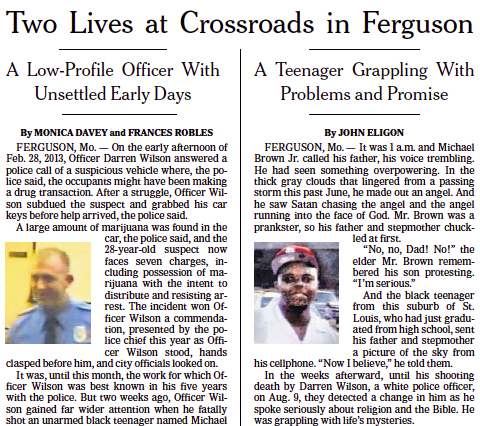
This morning, The New York Times published an A1 profile of Michael Brown to coincide with his burial. Written by John Eligon, the piece angered a lot of people. The paragraph cited most widely as evidence of the story’s frivolousness, sensationalism, and racial undertones reads:
Michael Brown, 18, due to be buried on Monday, was no angel, with public records and interviews with friends and family revealing both problems and promise in his young life. Shortly before his encounter with Officer Wilson, the police say he was caught on a security camera stealing a box of cigars, pushing the clerk of a convenience store into a display case. He lived in a community that had rough patches, and he dabbled in drugs and alcohol. He had taken to rapping in recent months, producing lyrics that were by turns contemplative and vulgar. He got into at least one scuffle with a neighbor.
Specifically, the observation that Brown was “no angel”—which a Times editor told Erik Wemple was a reference to a religious vision Brown had that was described in the piece’s opening paragraph—has been the subject of the greatest outrage and ridicule. It has spawned the Twitter hashtag #NoAngel and provoked the tongue-in-cheek reminder from Vox’s Matthew Yglesias that “Angels…are pretty rare.” When asked to respond to the criticism, executive editor Dean Baquet did not immediately reply, while public editor Margaret Sullivan suggested that she may write on the topic herself.
Regardless, Yglesias and others suggest that whether or not Brown was “angelic” is beside the point. Teenagers, white and black, rich and poor, are often emotionally volatile, dabble with drugs, listen to rap, attempt to rap, and commit petty crimes. Does that mean they deserve to be shot? Of course not, and, as Yglesias notes, when they’re white, they very rarely are.
But Eligon’s Times piece did not argue—and, it is safe to assume, did not mean to imply—that Michael Brown deserved to die. Yet there is no question the impression that emerges is one of an unusually troubled person. Given the circumstances, it’s an easy jump to suggesting that Brown is at least partly responsible for his fate.
The piece does include some mitigating anecdotes—that he had a nice smile, that he graduated from high school, that the rap lyrics in songs “he collaborated on” included denunciations of fathers who “don’t pay child support.” But the posthumous profile focuses overwhelmingly on his personal problems. As a child, Brown was a “handful” who climbed over the security gates his parents put up in their house and who wrote on the walls “when they left out pens and pencils,” Eligon wrote. As a teen, he bought a video game system with money meant to buy shoes. He sometimes talked back. Eligon quotes Brown’s friend as saying that he didn’t think the teen “ever threw a real punch,” then proceeds to recount in detail the one time the two boys descended into physical conflict. These ordinary developmental tribulations are presented as abnormal, even pathological.
Meanwhile, the accompanying profile of Darren Wilson, the cop who shot Brown, has largely been neglected by internet commenters. But the distinction in tone between the two is glaring. That story, written by Monica Davey and Frances Robles, which was partnered with the Brown piece in print and online, lends far more attention to environmental factors in describing Wilson’s development both as a human being and as a cop. We learn that his mother “carried out financial crimes,” including against his neighbor, who is quoted as saying that he had a “troubled childhood.” Meanwhile, the authors write, “Wilson’s formative experiences in policing came in a department that wrestled historically with issues of racial tension, mismanagement and turmoil.” The descriptions of Wilson’s personality portray him as “a good kid” and “a gentle, quiet man.” The emphasis on the fraught circumstances surrounding Wilson, rather than casting his actions as a reflection of his character, has the effect of depicting him as a kind of victim. In the sense that many of the shooting’s causes (from the personal to the social to the institutional) may have been out of his control, he probably is one.
But Wilson ultimately pulled the trigger, and Michael Brown is the person who was killed. And in parallel depictions of their lives, it’s unfair to belittle a dead teenager while giving his shooter the benefit of the doubt.


 Archives:
Archives: